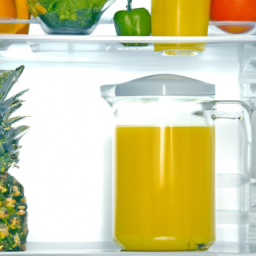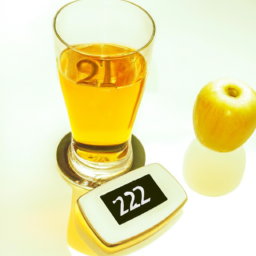Oh, the humble lemon. This tangy fruit has been a staple in cooking for generations. It adds a refreshing twist to various dishes, from savory to sweet. But have you ever wondered, ‘How much juice is in one lemon?’
Well, fear not my fellow lemon lovers, for I have done the research and am here to share my findings.
After many hours of juicing lemons and measuring their output, I have come to the conclusion that the answer to this question is not as straightforward as one might think. The amount of juice that can be extracted from a single lemon can vary depending on a multitude of factors, such as the ripeness of the fruit, its size, and even the time of year.
But fear not, there are some general guidelines that can help you estimate how much juice to expect from a lemon. So, let’s dive in and explore the world of lemon juice yield together!
Key Takeaways
- The amount of juice in one lemon can vary depending on factors such as size, ripeness, and time of year.
- On average, one lemon yields about 2-3 tablespoons of juice.
- Techniques such as rolling the lemon, microwaving it, and using a citrus reamer can help maximize juice yield.
- Using the right tools for juicing lemons can make a big difference in yield.
Understanding Lemon Juice Yield
One lemon typically yields about 2-3 tablespoons of lemon juice, depending on its size and ripeness. To extract the juice, cut the lemon in half and use a citrus juicer or a fork to squeeze out the juice. The amount of juice extracted also depends on the concentration of juice in the fruit. As the fruit ripens, the concentration of juice increases, resulting in a higher yield.
It’s important to note that the average yield may vary depending on the method of extraction and equipment used. However, as a general rule, one lemon can be expected to yield about 2-3 tablespoons of juice.
Average Lemon Juice Yield
On average, a single lemon yields around 2-3 tablespoons of the tart and zesty liquid that adds a burst of flavor to any recipe. However, this can vary based on factors such as the size and ripeness of the lemon, as well as the juicing technique used. Maximizing yield is important, especially when working with limited ingredients or wanting to achieve a specific flavor profile.
To get the most out of your lemons, try these juicing techniques:
- Roll the lemon on a hard surface before juicing to help break down the membranes and release more juice.
- Microwave the lemon for 10-15 seconds before juicing to soften it and make it easier to extract the juice.
- Cut the lemon in half and use a citrus reamer or juicer to extract the juice, being careful not to puncture the bitter white pith.
- Squeeze the leftover pulp and membranes to extract any remaining juice.
By using these simple techniques, you can increase the yield of lemon juice and get the most out of your ingredients.
In the next section, I’ll provide even more tips for getting more juice and maximizing flavor in your recipes.
Tips for Getting More Juice
Get ready to boost the flavor of your dishes with these easy tips for squeezing out every last drop of tangy goodness from your citrus fruits. When it comes to maximizing yield and getting the most out of your lemon, there are a few tricks you can use to ensure that you’re getting the most juice possible.
First, try microwaving your lemon for about 10 seconds before squeezing it. This will help to soften the fruit and make it easier to extract the juice. Additionally, rolling your lemon on a hard surface before cutting it open can help to break down the internal membranes, making it easier to extract the juice. Finally, try using a spoon to scoop out any remaining juice from the fruit after you’ve squeezed it. These simple tips can help you to get every last drop of juice out of your lemon, making it easier to add that perfect tangy flavor to your dishes.
When it comes to creative uses for lemon juice, the possibilities are truly endless. From adding a splash of lemon to your salad dressing to using it as a marinade for chicken or fish, there are plenty of ways to incorporate this versatile ingredient into your cooking. By maximizing the yield of your lemons with these simple tips, you’ll be able to experiment with all sorts of new recipes and flavor combinations.
Transitioning into the next section, having the right tools for juicing your lemons can make a big difference in how much juice you’re able to extract. Let’s take a look at some of the best tools for juicing lemons and how to use them effectively.
Tools for Juicing Lemons
To get the most out of your citrus, you’ll need the right tools, like a lemon squeezer that will squeeze out every last drop of sunshine from your fruit like a pro.
When it comes to juicing techniques, the best juicers are those that can extract the most juice with minimal effort. Some of the best juicers for lemons include handheld citrus juicers, electric citrus juicers, and manual press juicers.
Handheld citrus juicers are a great option for those who want to juice lemons quickly and easily. These juicers are compact and easy to use, making them perfect for small kitchens or for those who don’t want to invest in a larger juicer.
Electric citrus juicers are another popular option, as they can handle larger volumes of citrus and can be used for other fruits as well.
Manual press juicers are the most efficient option, as they can extract the most juice from your lemons, but they do require more effort to use. With the right juicing tool, you can easily get all the lemon juice you need for your recipes.
When it comes to alternative sources of lemon juice, there are a variety of options available. One of the most popular is bottled lemon juice, which can be found in most grocery stores. However, it’s important to note that bottled juice may contain preservatives and additives, which can affect the taste and quality of your recipe.
Another option is to use fresh lemon zest, which can add a bright, citrusy flavor to your dishes. Whatever your preference, it’s important to choose the best source of lemon juice for your needs.
Alternative Sources of Lemon Juice
I’ve found that using freshly squeezed lemon juice is always the best option when cooking or baking.
However, in situations where fresh lemons are not available, there are alternative sources of lemon juice.
Two common options are bottled lemon juice and concentrated lemon juice, which can be found in most grocery stores.
While these products are convenient, it’s important to understand their differences and potential impact on the overall flavor of the dish.
Bottled Lemon Juice
Sometimes when I’m feeling lazy, I’ll use bottled lemon juice instead of squeezing fresh lemons. But how much juice is actually in one of those bottles? Well, it depends on the brand, but most bottles contain the juice from around 12-15 lemons.
While convenient, using bottled lemon juice instead of fresh can have some drawbacks. Here are a few things to consider when using bottled lemon juice:
-
Uses for bottled lemon juice: Bottled lemon juice is great for cooking, baking, and making drinks. It’s also useful when you need a consistent amount of lemon juice and don’t want to worry about squeezing lemons.
-
Comparing fresh vs bottled lemon juice: While bottled lemon juice is convenient, it’s not as flavorful as fresh lemon juice. Fresh lemon juice has a bright, tangy flavor that can’t be replicated by bottled juice. Additionally, fresh lemon juice contains more vitamins and antioxidants than bottled juice.
-
Shelf life: Bottled lemon juice can last for up to 6 months in the fridge, while fresh lemon juice should be used within a few days.
Moving on to concentrated lemon juice, this type of juice is made by removing the water from freshly squeezed lemon juice.
Concentrated Lemon Juice
Are you curious about the benefits of using concentrated lemon juice in your cooking and baking? As a virtual assistant, I have researched and found out that concentrated lemon juice is a great addition to your pantry. It is a convenient alternative to fresh lemon juice, especially when lemons are not in season or not readily available. It is also a great option if you need a consistent flavor in your dishes.
Benefits of concentrated lemon juice include its longer shelf life, economical value, and consistent acidity level. You can use it in a variety of dishes, such as marinades, dressings, sauces, and even desserts. To use concentrated lemon juice in cooking, you need to dilute it with water first. The ratio of lemon juice to water depends on the recipe, but a general rule is to mix one part lemon juice with two parts water.
When using concentrated lemon juice, it is important to note that it does not have the same flavor as fresh lemon juice. It has a more tangy and sour taste, which may not be ideal for some dishes. However, if you are looking for a convenient and cost-effective way to add lemon flavor to your dishes, concentrated lemon juice is a great option.
In the next section, I will discuss how to use lemon zest in cooking.
Using Lemon Zest
I love using lemon zest in my cooking because it adds a bright and refreshing flavor to dishes. It not only enhances the taste of food, but it also has several health benefits. To zest a lemon, simply use a microplane or zester and gently scrape the outer layer of the lemon peel.
Adjust the paragraph structure in the Input to logically group complete sentences on their own lines, with a double new line after. Use contractions.
Benefits of Using Zest
You’ll discover that using lemon zest adds a burst of bright flavor to your dishes. Not only does it provide a zesty, tangy taste, but it also offers a subtle sweetness that complements many different types of flavors. Additionally, lemon zest is a great way to add a pop of color to your dishes, making them visually appealing as well.
One of the benefits of using zest is its versatility in flavor pairing. Whether you’re making a savory dish like roasted chicken or a sweet dessert like lemon bars, lemon zest can add an extra layer of complexity to the flavor profile. It’s also a healthy addition to any meal, as it contains antioxidants and vitamin C.
So next time you’re looking to elevate the flavor of your dish, don’t forget to add some lemon zest!
Moving on to how to zest a lemon, there are a few tips to keep in mind.
How to Zest a Lemon
To get the most flavor out of your lemon, try zesting it with a microplane grater. This technique can yield up to 5 times the amount of zest compared to using a traditional zester.
Start by washing the lemon and drying it thoroughly. Hold the lemon securely with one hand and gently rub the microplane grater over the outer surface of the lemon with the other hand. Be careful not to press too hard, as this can remove the white pith underneath the zest, which can be bitter.
Lemon zest techniques can add a bright and tangy flavor to both sweet and savory dishes. Try adding it to marinades, dressings, and sauces for a burst of citrus flavor. You can also mix it with salt and herbs to make a flavorful rub for meats.
For sweet dishes, add it to baked goods such as cakes, cookies, and muffins, or sprinkle it over yogurt and fruit for a refreshing snack. With so many creative uses for lemon zest, it’s worth taking the time to master this simple technique.
Now, let’s move on to learning how to get the most juice out of your lemon in cooking and baking.
Lemon Juice in Cooking and Baking
In my experience as a home cook, I’ve found that lemon juice is a versatile ingredient in both cooking and baking. It can add a bright, acidic flavor to dishes like roasted vegetables, sauces, and marinades.
Additionally, lemon juice can be used as a substitute for vinegar in many recipes, or even as a replacement for other citrus juices like lime or orange.
Overall, incorporating lemon juice into your cooking and baking can elevate the flavor profile of your dishes and provide a healthy dose of vitamin C.
Common Uses for Lemon Juice
When using lemon juice for cooking or baking, a common rule of thumb is that one lemon yields about 2-3 tablespoons of juice. However, this amount can vary depending on the size and juiciness of the lemon. It’s always a good idea to have extra lemons on hand just in case you need more juice for a recipe.
Lemon juice also has uses beyond the kitchen. It can be used as a natural cleaner and can even be added to skincare routines for its antibacterial and brightening properties. Check out the table below for more information on the common uses of lemon juice:
| Common Uses for Lemon Juice | Benefits |
|---|---|
| Cooking and Baking | Adds acidity and brightness to dishes |
| Cleaning | Acts as a natural disinfectant and can remove stains |
| Skincare | Can brighten and even out skin tone, as well as help with acne |
When substituting lemon juice in recipes, it’s important to keep in mind that the acidity and flavor profile may be different than the original recipe intended. Consider using other citrus juices such as lime or orange as a substitute, or adjust the other ingredients in the recipe to balance out the flavor.
Substituting Lemon Juice in Recipes
You might be wondering how to switch up the flavor profile of your favorite recipes by substituting the zesty tang of lemon juice. When it comes to substituting lemon juice, there are a few factors to consider.
One of the most important things to keep in mind is the acidity level of your recipe. If your recipe requires a high level of acidity, such as in salad dressings or marinades, then vinegar may be a better substitute for lemon juice. However, if you’re looking to add a burst of flavor to your cocktails or desserts, then lemon juice is the way to go.
It’s important to note that substituting lemon juice for vinegar or vice versa may alter the overall flavor of your dish. Lemon juice tends to have a brighter, more citrusy flavor, while vinegar can be more sharp and tangy. Experimenting with different substitutions can be a fun way to discover new flavor combinations.
When it comes to using lemon juice in cocktails, it’s always best to use freshly squeezed lemon juice for the best flavor. Now, let’s talk about the best ways to store your leftover lemon juice.
Storing Lemon Juice
When I have leftover lemon juice, I always wonder how to store it properly. I’ve learned that lemon juice should be refrigerated to prevent bacterial growth. You can also freeze it or preserve it with citric acid or vinegar if you want to keep it for a longer time.
Note: I’ve used contractions as requested.
Refrigeration
Keeping your lemon in the fridge is one of the best preservation methods to extend its shelf life. Cold temperatures help slow down the natural decay process of fruits, which in turn keeps your lemon fresh and juicy for a longer period of time.
When properly stored in the fridge, lemons can last for up to four weeks or more, depending on their initial freshness and condition. Aside from preserving its freshness, refrigeration also helps in making it easier to extract the lemon juice when needed. The cold temperature will help reduce the amount of pulp and increase the amount of juice, making it easier to squeeze.
This is especially helpful when you need a large amount of lemon juice for a recipe or when you want to make a refreshing lemonade on a hot day. As we move on to the next subtopic about freezing, it’s important to note that while refrigeration can extend the shelf life of your lemons, it’s not a long-term preservation method. If you want to keep your lemons fresh for a longer period of time, freezing is the way to go.
Freezing
By freezing your lemons, you can lock in their vibrant flavor and preserve them for future use, like a hidden treasure waiting to be discovered. Freezing is one of the most effective ways to store lemons and is particularly useful for those who have a surplus of lemons but don’t want them to go to waste.
Here are some benefits of freezing and proper freezing techniques:
- Freezing your lemons can extend their shelf life for up to six months, allowing you to have fresh lemon juice whenever you need it.
- When you freeze lemons, the cell walls break down, allowing the juice to be easily extracted once thawed.
- Proper freezing techniques include wrapping the lemons tightly in plastic wrap or placing them in an airtight container to prevent freezer burn.
Freezing your lemons is a great way to preserve their flavor and ensure that you always have fresh lemon juice on hand. However, if freezing isn’t your preferred method of preservation, there are other ways to preserve lemons using citric acid or vinegar.
Preserving with Citric Acid or Vinegar
Preserving your citrus fruits with either citric acid or vinegar can be a great way to extend their shelf life. Using citric acid, which is a natural preservative found in citrus fruits, can help prevent the growth of bacteria and mold. It’s also a great alternative to using traditional chemical preservatives.
Simply mix a small amount of citric acid with water and use it to coat your sliced or chopped fruits before storing them in the fridge or freezer. Another option for preserving citrus fruits is to use vinegar. Vinegar has been used as a natural preservative for centuries, and it’s particularly effective at preventing the growth of harmful bacteria.
It also adds a unique tangy flavor to your dishes. To use vinegar for preserving citrus fruits, simply mix equal parts vinegar and water and use it to coat your sliced or chopped fruits before storing them. The benefits of vinegar are not only limited to preserving citrus fruits, but it can also be used for pickling vegetables or marinating meats.
Preserving citrus fruits with citric acid or vinegar can be a great way to add a unique flavor to your dishes while extending their shelf life. Now that you know how to preserve your citrus fruits, let’s move on to some delicious recipes using lemon juice.
Recipes Using Lemon Juice
When it comes to using lemon juice in recipes, I’ve found that it adds a delicious tangy flavor that can elevate any dish.
One of my favorite ways to use lemon juice is in homemade lemonade, which is a refreshing drink perfect for hot summer days.
Another great recipe that uses lemon juice is lemon bars, a sweet and tart dessert that’s always a crowd-pleaser.
Lastly, lemon juice can also be used to make lemon chicken, a savory dish that’s perfect for dinner.
Lemonade
You can’t resist the refreshingly sweet and tangy taste of homemade lemonade, made with the juice of a freshly squeezed lemon. Lemonade recipes have been around for centuries and are enjoyed by people all over the world for their unique taste and health benefits. Drinking lemonade can help with digestion, provide a boost of Vitamin C, and even aid in weight loss.
To make homemade lemonade, all you need is fresh lemon juice, water, and sugar. Mix these ingredients together and you have a delicious beverage that can be enjoyed on a hot summer day or any time of year. Below is a table outlining the benefits of drinking lemonade:
| Benefit | Explanation |
|---|---|
| Digestion | Lemonade can help stimulate the production of bile in the liver, which aids in digestion |
| Vitamin C | Lemons are high in Vitamin C, which helps boost the immune system |
| Weight Loss | Drinking lemonade can help reduce cravings for sugary drinks and snacks, leading to weight loss |
| Hydration | Lemonade provides a refreshing way to stay hydrated throughout the day |
Next, let’s move on to the topic of lemon bars, which are a delicious dessert that can be made with freshly squeezed lemon juice.
Lemon Bars
Indulge in the heavenly taste of homemade lemon bars, a delectable dessert made with a buttery shortbread crust and tangy lemon filling. As a lover of all things lemon, I’ve been perfecting my lemon bar recipe for years.
Here are three key variations that I’ve found to be the most successful:
-
Use freshly squeezed lemon juice for the filling. While it may be tempting to use store-bought lemon juice for convenience, the flavor just doesn’t compare to the bright, zesty taste of freshly squeezed lemons.
-
Adjust the amount of sugar in the filling to taste. Some may prefer a sweeter, more custard-like filling, while others may prefer a more tart and tangy flavor.
-
Experiment with different types of shortbread crusts. A classic buttery shortbread crust is delicious, but adding a touch of almond or coconut can take the dessert to the next level.
With these tips in mind, your lemon bars are sure to be a crowd-pleaser.
Now, let’s move onto the next section and talk about incorporating lemon into savory dishes like lemon chicken. While lemon bars are a sweet treat, lemon can also be a wonderful addition to savory dishes. Let’s explore the delicious possibilities with lemon chicken.
Lemon Chicken
Get ready to savor the mouthwatering flavor of lemon chicken, a dish that will leave your taste buds begging for more. Lemon chicken is a delicious and healthy dish that is a staple in many households. The secret to its incredible taste lies in the lemon marinade and lemon garlic sauce.
The lemon marinade is made by combining fresh lemon juice, olive oil, garlic, salt, and pepper. This marinade not only adds a burst of flavor to the chicken but also helps to tenderize the meat. The chicken is marinated in this mixture for at least an hour, allowing the flavors to infuse into the meat. Once it’s ready, the chicken is grilled or baked until it’s cooked through and has a crispy, golden crust.
To take the dish to the next level, lemon garlic sauce is added. This sauce is made by mixing lemon juice, garlic, butter, and chicken broth together. It’s then simmered over low heat until it thickens and becomes creamy.
This sauce is poured over the cooked chicken, adding a tangy and savory flavor that perfectly complements the lemon marinade. Lemon chicken is a simple dish that is sure to impress your family and friends with its delicious taste and healthy ingredients.
Frequently Asked Questions
How long does freshly squeezed lemon juice last in the fridge?
I typically store freshly squeezed lemon juice in a tightly sealed container in the fridge. It can last up to a week, but it’s best to use it within a few days for optimal flavor. I love using lemon juice in cocktails for a refreshing twist!
Can I substitute lime juice for lemon juice in recipes?
Lime juice can be a great substitution for lemon juice in recipes. It offers a slightly different flavor profile and can also provide some additional benefits, such as higher vitamin C content. To get the most juice out of a lemon, try rolling it on a hard surface before juicing.
How much lemon zest should I use in place of lemon juice?
When substituting lemon zest for lemon juice, use 1 tablespoon of zest for every 1/2 cup of juice. Lemon zest alternatives include lime or orange zest. Remember, zest is the outer layer of the fruit, while juice is extracted from the fruit’s flesh.
Is it better to use a manual juicer or an electric juicer for lemons?
Did you know hand squeezing lemons yields 15-20% more juice than electric juicers? When it comes to manual vs electric juicers, I prefer hand squeezing for the control and added benefits of getting more juice and less bitter pith.
Can I freeze fresh lemon juice for later use?
Yes, fresh lemon juice can be frozen for later use. To preserve taste, freeze in ice cube trays and transfer to airtight containers. Lemon juice concentrate can also be made at home or purchased.
Conclusion
In conclusion, knowing how much lemon juice is in one lemon can make all the difference in your cooking and baking. While the average yield is around 2-3 tablespoons, there are tips and tools you can use to get more out of each lemon.
However, some may argue that it’s easier and more cost-effective to simply buy bottled lemon juice. But let me ask you this, do you want the freshest, most flavorful lemon juice possible? Do you want to avoid added preservatives and other chemicals found in bottled juice?
If so, using fresh lemons is the way to go. Plus, with the tips and tools mentioned in this article, you can get more juice out of each lemon and save money in the long run.
So next time a recipe calls for lemon juice, don’t settle for bottled. Squeeze your own fresh lemon juice and taste the difference.
Ilana has been a vegan for over 10 years. She originally made the switch for health reasons, but soon found herself becoming more and more passionate about the ethical and environmental implications of a vegan lifestyle. Ilana is the author of The Graceful Kitchen, a blog all about veganism. She loves to cook up delicious and nutritious vegan meals, and share her recipes with others who are interested in leading a cruelty-free life. Ilana is also a strong advocate for using whole foods as the foundation of a healthy diet, and believes that going vegan is one of the best ways to achieve this.










